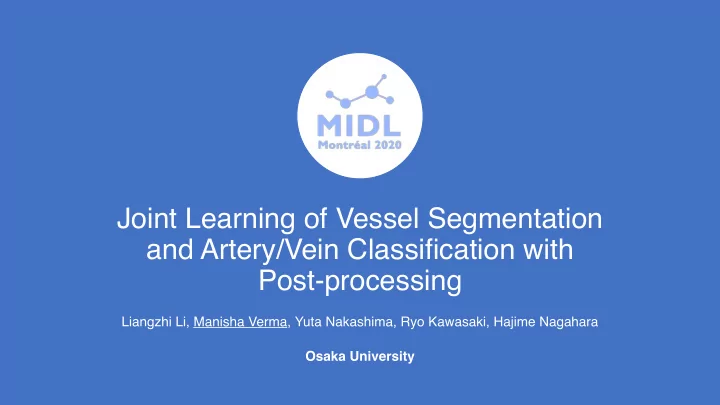

Joint Learning of Vessel Segmentation and Artery/Vein Classification with Post-processing Liangzhi Li, Manisha Verma, Yuta Nakashima, Ryo Kawasaki, Hajime Nagahara Osaka University
Background • Retinal imaging is the only feasible way to directly inspect the vessels in the human body. • Retinal segmentation and classification are important to help diagnosis of diabetes, hypertension, arterial hardening, etc. (a) Raw image. (b) Vessel segmentation. (c) Artery/Vein classification. July 2020 2/10 Joint Learning of Vessel Segmentation and Artery/Vein Classification (MIDL2020)
Problems • Retina images are usually complicated and full of noises. • The available training data are very limited. • In most of the public datasets, the number of retina images for training is no more than 20. • Vessel classification is more difficult because of [1] (a) Raw image. (b) Prediction Errors . the data unbalance. [1] Galdran, A., Meyer, M., Costa, P., & Campilho, A. (2019, April). Uncertainty-aware artery/vein classification on retinal images. In 2019 IEEE 16th International Symposium on Biomedical Imaging (ISBI 2019) (pp. 556-560). IEEE. July 2020 3/10 Joint Learning of Vessel Segmentation and Artery/Vein Classification (MIDL2020)
Our Solution • UNet-like models depend more on local cues, such as color and contrast, rather than the structure of the whole vessel system. Errors happen along vessel segments Errors happen around crossing or branching points • Therefore, we design our method with two components. • A neural model that segments and classifies vessels. • A post-processing algorithm to refine initial classification results. July 2020 4/10 Joint Learning of Vessel Segmentation and Artery/Vein Classification (MIDL2020)
SeqNet Model • Two streams for segmentation and classification. [1] • Element-wise multiplication with the segmentation results to simplify the classification task. • Two results are merged to obtain accurate vessel map. [1] Li, L., Verma, M., Nakashima, Y., Nagahara, H., & Kawasaki, R. (2020). Iternet: Retinal image segmentation utilizing structural redundancy in vessel networks. In The IEEE Winter Conference on Applications of Computer Vision (pp. 3656-3665). July 2020 5/10 Joint Learning of Vessel Segmentation and Artery/Vein Classification (MIDL2020)
Post-processing (Vessel Map Analysis) • Key-points include the crossing points and the end points. • Crossing points are pixels with more than two neighbors, while terminal points only have no more than one neighbor. • Pixels between connected key-points are extracted as a segment. (a) Vessel Skeleton (b) Key-points (c) Segments July 2020 6/10 Joint Learning of Vessel Segmentation and Artery/Vein Classification (MIDL2020)
Post-processing (Intra-segment) • A common prediction error is the inconsistency along one segment. • We constraint pixels in each segment can only have one single label. • Its category is given by the sum of each pixel’s confidence. (a) Ground-truth Label. (b) Prediction Error. (c) Post-processed Result. July 2020 7/10 Joint Learning of Vessel Segmentation and Artery/Vein Classification (MIDL2020)
Post-processing (Inter-segment) • Another kind of error usually happens around crossing and branching points. • An observation is that classification failures come with low confidences. • They may be corrected by their (a) Ground-truth Label. (b) Prediction Error. connecting. • We introduced the inter-segment prediction propagation, in which the label of a segment is propagated to its connected segments. July 2020 8/10 Joint Learning of Vessel Segmentation and Artery/Vein Classification (MIDL2020)
Experimental Results • The proposed method achieves higher AUC, as our model avoids deterioration of the segmentation performance. • Also, it shows higher classification accuracy on both datasets. July 2020 9/10 Joint Learning of Vessel Segmentation and Artery/Vein Classification (MIDL2020)
Works well on other datasets (no FT) Paper: https://arxiv.org/abs/2005.13337 Code : https://github.com/conscienceli/SeqNet (Pretrained weights available) July 2020 10/10 Joint Learning of Vessel Segmentation and Artery/Vein Classification (MIDL2020)
Recommend
More recommend